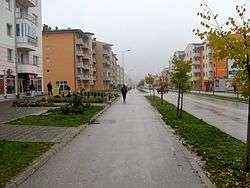
Istočno Novo Sarajevo
Istočno Novo Sarajevo (Serbian Cyrillic: Источно Ново Сарајево), is a municipality in Republika Srpska, Bosnia and Herzegovina. It was created from part of the pre-war municipality of Novo Sarajevo (the other part of the pre-war municipality is now in the Federation of Bosnia and Herzegovina).
East New Sarajevo is one of the six municipalities of the City of East Sarajevo (Bosnian, Croatian, Serbian: Grad Istočno Sarajevo; Serbian Cyrillic: Град Источно Сарајево).
Etymology
The municipality was formerly known as Srpsko Novo Sarajevo (Serbian Cyrillic: Српско Ново Сарајево) and Lukavica (Serbian Cyrillic: Лукавица).
Education
In East New Sarajevo there is one elementary school "Sveti Sava" (Grades 1–9) and one high school "Srednja stručna škola 28. Juni". Four of faculties that are members of The University of East Sarajevo has their seats in Istočno Novo Sarajevo. Those are Faculty of electrical engineering, Faculty of mechanical engineering, Music academy and Faculty of agriculture.

Novo Sarajevo
Novo Sarajevo (Serbian Cyrillic: Ново Сарајево, pronounced [nôʋoː sǎrajeʋo]; "New Sarajevo") is a municipality in Sarajevo, and Sarajevo Canton, Bosnia and Herzegovina.
Neighborhoods
History
Like Novi Grad, Novo Sarajevo is a product of the city's massive growth and development in the 1960s and 1970s. It is located in the middle of the Sarajevo field, predominantly on the northern bank of the Miljacka, between Novi Grad and Centar.
Prior to the siege, Novo Sarajevo had some 47.6 km² (41.6% Forest, 17.5% Meadows, 13.5% Commercial/Building Land, 10.4% Grass-land, 8.4% Ploghland, 13.5% Gardens). Following the Siege of Sarajevo, 75% of the lesser populated urban area was transferred to the Republika Srpska (established as Istočno Novo Sarajevo), leaving Novo Sarajevo municipality with 11.43 km². As a result, Novo Sarajevo has the highest number of people per km², some 7524.

Sarajevo
Sarajevo (Bosnia/Croatian/Serbian cyrillic Сарајево) (Serbo-Croatian pronunciation: [sǎrajeʋo]) is the capital and largest city of Bosnia and Herzegovina, with an estimated population of 369,534. The Sarajevo metropolitan area, including Sarajevo, East Sarajevo and surrounding municipalities, is home to 688,354 inhabitants. Moreover, it is also the capital of the Federation of Bosnia and Herzegovina entity,and the center of the Sarajevo Canton. Nestled within the greater Sarajevo valley of Bosnia, it is surrounded by the Dinaric Alps and situated along the Miljacka River in the heart of Southeastern Europe and the Balkans.
Sarajevo is the leading political, social and cultural center of Bosnia and Herzegovina, a prominent center of culture in the Balkans, with its region-wide influence in entertainment, media, fashion, and the arts.
The city is famous for its traditional cultural and religious diversity, with adherents of Islam, Orthodoxy, Judaism and Catholicism coexisting there for centuries. Due to its long and rich history of religious and cultural variety, Sarajevo is sometimes called the "Jerusalem of Europe" or "Jerusalem of the Balkans". It was, until late in the 20th century, the only major European city to have a mosque, Catholic church, Orthodox church and synagogue within the same neighborhood. A regional center in education, the city is also home to the Balkans' first institution of tertiary education in the form of an Islamic polytechnic called the Saraybosna Osmanlı Medrese, today part of the University of Sarajevo.
Sarajevo (1940 French film)
Sarajevo (French:De Mayerling à Sarajevo) is a 1940 French historical film directed by Max Ophüls and starring Edwige Feuillère, John Lodge and Aimé Clariond. Beginning in the aftermath of the Mayerling Incident the film portrays the love affair and marriage between Archduke Franz Ferdinand of Austria and Sophie, Duchess of Hohenberg, leading up to their eventual assassination in 1914 in events that triggered the First World War. The film was not a commercial or critical success. Following the German occupation of France the film was banned, and Ophüls fled into exile for the second time.
Partial cast
Sarajevo (1940 Hungarian film)
Sarajevo is a 1940 Hungarian historical film directed by Ákos Ráthonyi and starring Maria von Tasnady, Ferenc Kiss and József Timár. The film is set against the backdrop of events leading up to the assassination of Archduke Franz Ferdinand of Austria in 1914.
Partial cast
External links
Podcasts:

